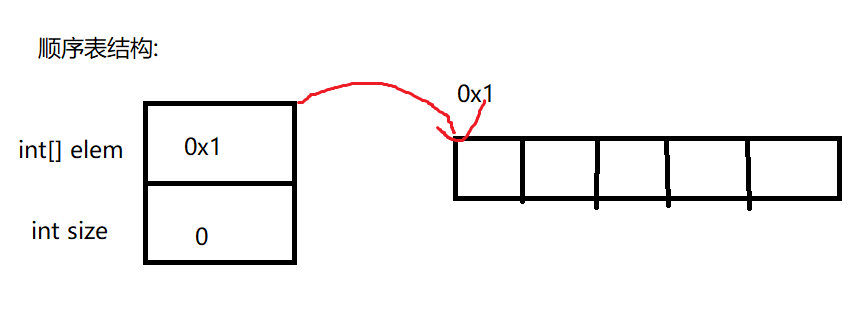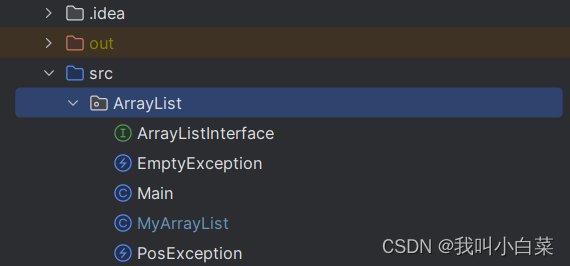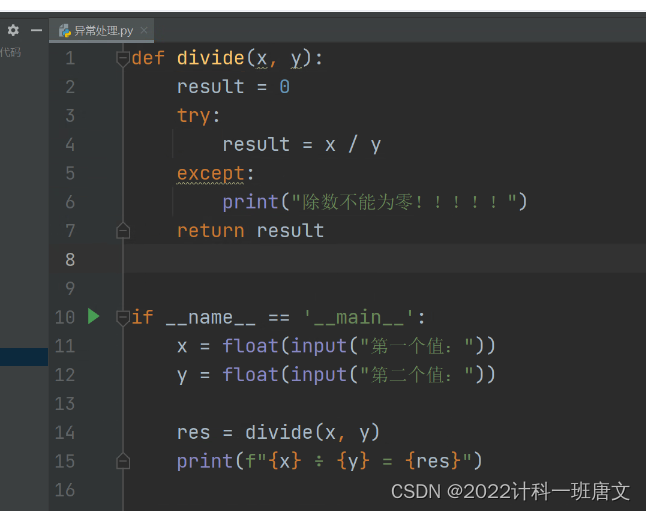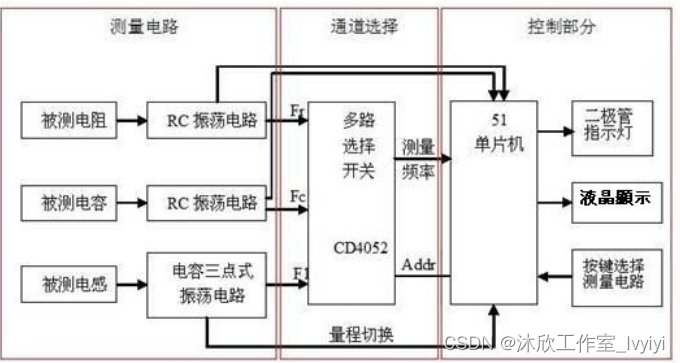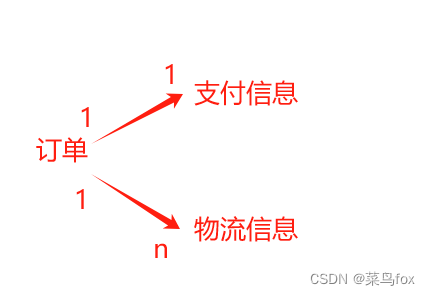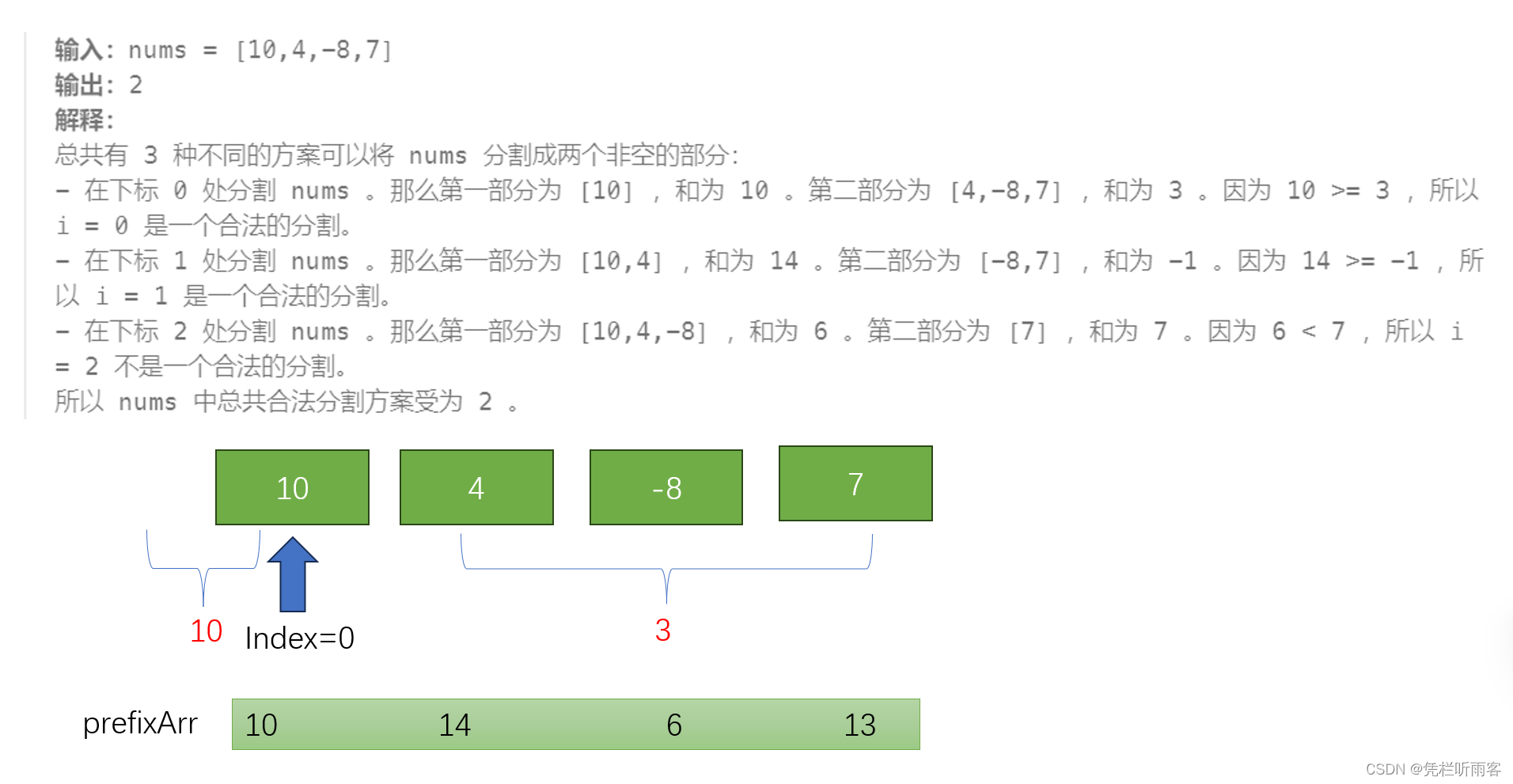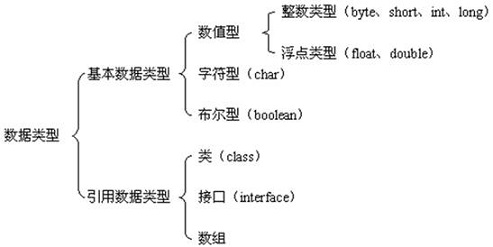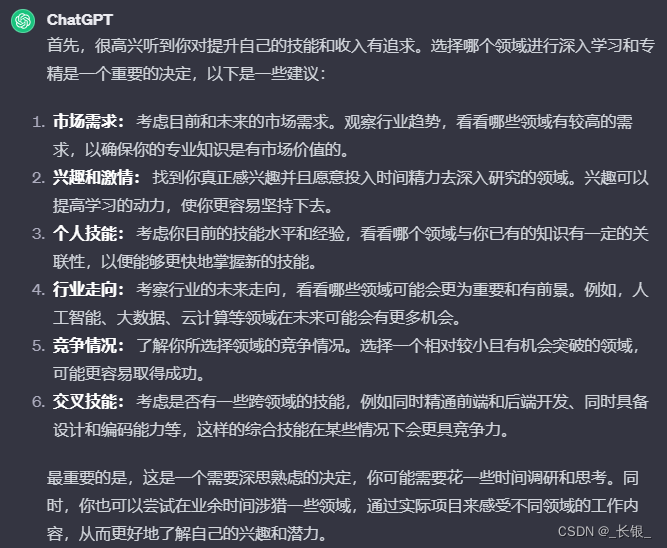顺序表存储数据的具体实现方案是:将数据全部存储到一整块内存空间中,数据元素之间按照次序挨个存放。

一、顺序表的特性
逻辑结构:线性结构
存储结构:顺序存储
特点:内存连续,大小是固定的。
操作:增删改查
二、数组操作
例题:
int a[100]={1,2,3,4,5,6,7,8};
函数命名规则:
下划线法:create_empty_seqlist
小驼峰法:createEmptySeqList
大驼峰法:CreateEmptySeqList
#include <stdio.h>
/* (1)插入数组元素
功能:向数组的第几个位置插数据
函数:void insetIntoA(int *p,int n, int post, int data);
参数:
int *p: 保存数组首地址
int n: 有效数据元素的个数
int post: 插入元素下标
int data: 数据
*/
void insertIntoA(int *p, int n, int post, int data)
{
//1. 把从最后一个元素p[n-1]到插入位置元素p[post]向后移动一个单位
for (int i = n - 1; i >= post; i--)
p[i + 1] = p[i];
//2. 插入新元素data到指定位置
p[post] = data;
}
/* (2)遍历数组
功能:遍历数组中的有效元素
函数:void showA(int *p,int n);
参数:
int *p:保存数组收地址
int n:有效数据元素的个数
*/
void showA(int *p, int n) //p=a,n=8;
{
int i;
for (i = 0; i < n; i++)
printf("%d ", p[i]);
printf("\n");
}
/* (3)删除数组元素
功能:删除数组中指定元素
函数:void deleteIntoA(int *p,int n, int post);
参数:
int *p: 保存数组首地址
int n: 有效数据元素的个数
int post: 删除元素下标
*/
void deleteIntoA(int *p, int n, int post) //a的值 9 4
{
int i;
//从删除位置的后一个元素p[post+1]到最有后一个元素p[n-1]往前移动一个单位
for (i = post + 1; i < n; i++) //for(i=4+1;i<9;i++)
p[i - 1] = p[i];
}
int main(int argc, char const *argv[])
{
int a[100] = {
1, 2, 3, 4, 5, 6, 7, 8};
showA(a, 8);
insertIntoA(a, 8, 2, 100);
showA(a, 9);
deleteIntoA(a, 9, 4);
showA(a, 8);
return 0;
}
插入元素不会增加空间,导致元素丢失
删除元素不会减少遍历。
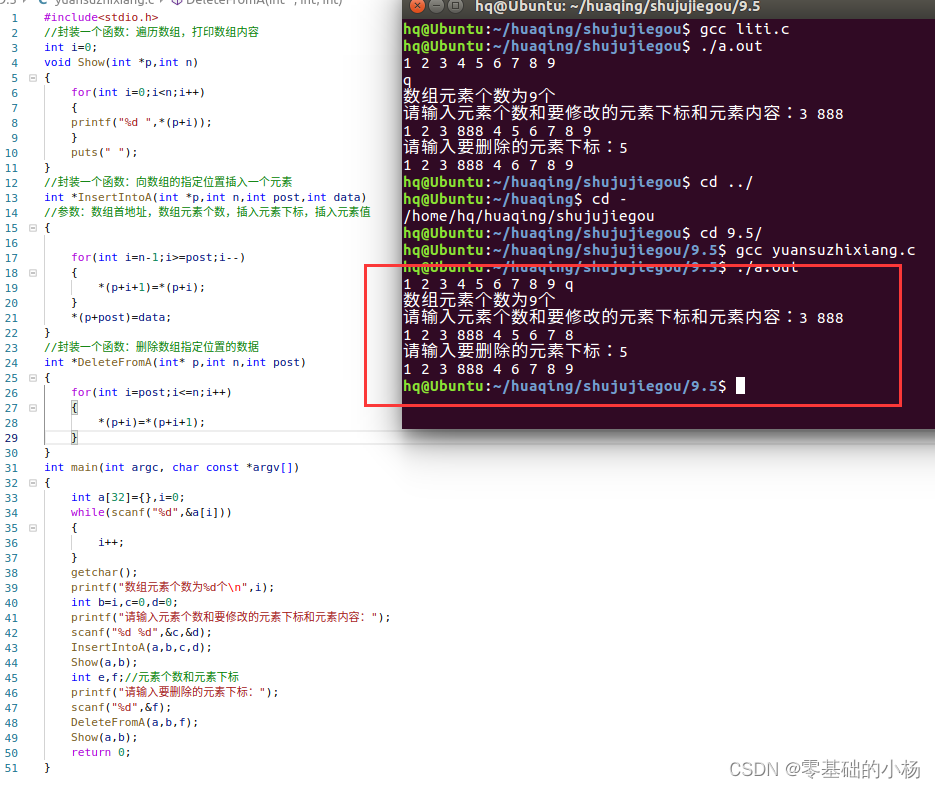
三、 数组操作优化:通过添加全局变量
添加全局变量last表示最后一个有效元素下标
#include <stdio.h>
int last = 7; //代表最后一个有效元素得下标 last=有效元素个数-1
/* (1)插入数组元素
功能:向数组的第几个位置插数据
函数:void insetIntoA(int *p,int post, int data);
参数:
int *p: 保存数组首地址
int post: 插入元素下标
int data: 数据
*/
void insertIntoA(int *p, int post, int data)
{
//1. 把从最后一个元素p[last]到插入位置元素p[post]向后移动一个单位
for (int i = last; i >= post; i--)
p[i + 1] = p[i];
//2. 插入新元素data到指定位置
p[post] = data;
//3. 最后一个有效元素下标+1
last++;
}
/* (2)遍历数组
功能:遍历数组中的有效元素
函数:void showA(int *p);
参数:
int *p:保存数组收地址
*/
void showA(int *p)
{
int i;
for (i = 0; i <= last; i++)
printf("%d ", p[i]);
printf("\n");
}
/* (3)删除数组元素
功能:删除数组中指定元素
函数:void deleteIntoA(int *p,int post);
参数:
int *p: 保存数组首地址
int post: 删除元素下标
*/
void deleteIntoA(int *p, int post)
{
int i;
//1.从删除位置的后一个元素p[post+1]到最有后一个元素p[last]往前移动一个单位
for (i = post + 1; i <= last; i++)
p[i - 1] = p[i];
//2.将最后一个有效元素下标减一
last--;
}
int main(int argc, char const *argv[])
{
int a[100] = {
1, 2, 3, 4, 5, 6, 7, 8};
showA(a); //1 2 3 4 5 6 7 8
insertIntoA(a, 2, 100);
showA(a); //1 2 100 3 4 5 6 7 8
deleteIntoA(a, 4);
showA(a); //1 2 100 3 5 6 7 8
return 0;
}
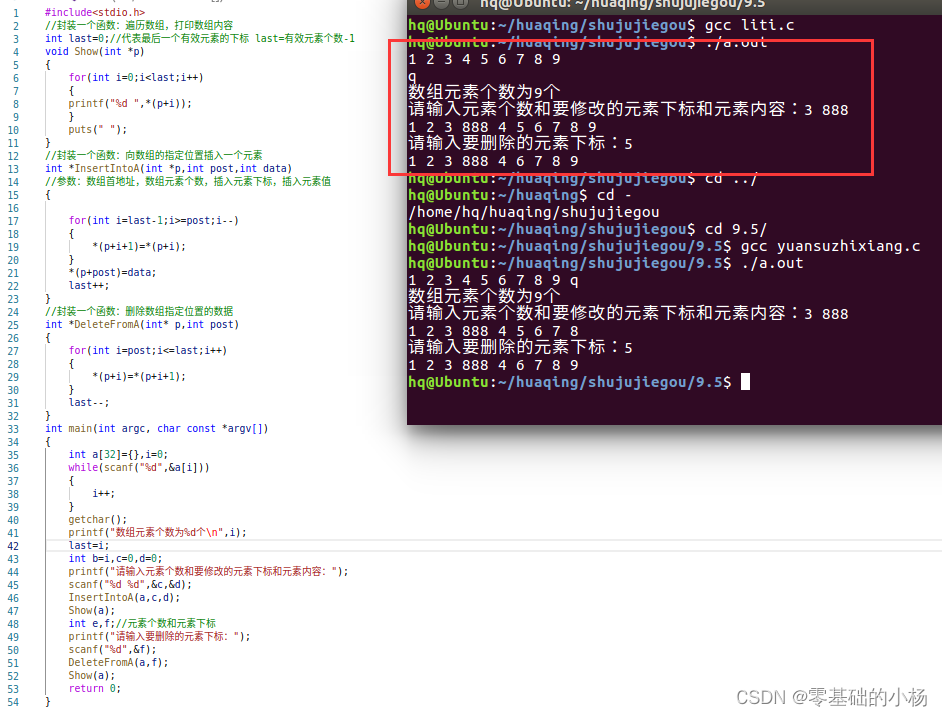
四、顺序表的实现
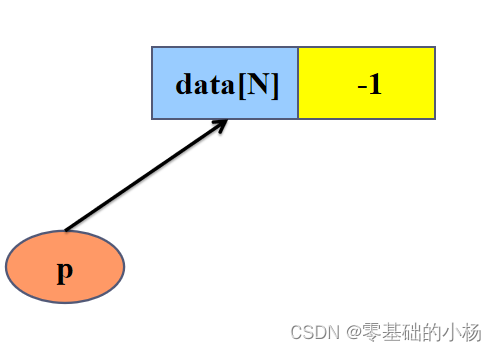
#include <stdio.h>
#include <stdlib.h>
#define N 10
typedef int datatype; //int a; <==> datatype a;
typedef struct seqlist
{
datatype data[N]; //相当于int data[N];
int last; //代表数组中最后一个有效元素得下标
} seqlist_t;
//struct seqlist s; 相当于 seqlist_t s;
//创建空顺序表
seqlist_t *CreateEpSeqlist()
{
//1.动态申请一块空间存放顺序表
seqlist_t *p = (seqlist_t *)malloc(sizeof(seqlist_t));
if (NULL == p)
{
perror("CreateEpSeqlist p malloc err");
return NULL;
}
//2.对last初始化
p->last = -1;
return p;
}
//判断顺序表是否为满,满返回1,未满返回0。
int IsFullSeqlist(seqlist_t *p)
{
return p->last + 1 == N;
}
//向顺序表的指定位置插入
int InsertIntoSeqlist(seqlist_t *p, int post, int data)
{
int i;
//1.容错判断
if (post < 0 || post > p->last + 1 || IsFullSeqlist(p))
{
printf("InsertIntoSeqlist post err\n");
return -1; //错误返回
}
//2.从下标为post到last的元素往后移动一个单位
for (i = p->last; i >= post; i--)
p->data[i + 1] = p->data[i];
//3.插入数据
p->data[post] = data;
//4.让last加一
p->last++;
return 0;
}
//遍历顺序表sequence顺序list表。
void ShowSeqlist(seqlist_t *p)
{
for (int i = 0; i <= p->last; i++)
printf("%d ", p->data[i]);
printf("\n");
}
//判断顺序表是否为空,为空返回1,不为空返回0。
int IsEpSeqlist(seqlist_t *p)
{
return p->last == -1;
}
//删除顺序表中指定位置的数据,post为删除位置
int DeleteIntoSeqlist(seqlist_t *p, int post)
{
//1.容错判断
if (IsEpSeqlist(p) || post < 0 || post > p->last)
{
printf("DeleteIntoSeqlist err!\n");
return -1;
}
//2.从下标为post+1到最后下标为last的位置的元素向前移动一个单位
for (int i = post + 1; i <= p->last; i++)
p->data[i - 1] = p->data[i];
//3.让有效元素下标p->last减一
p->last--;
return 0;
}
//清空顺序表(清空:访问不到,但是内存中还有。销毁:内存清空)
void ClearSeqList(seqlist_t *p, int post)
{
p->last = -1; //让最后一个有效元素下标last为-1代表顺序表为空
}
//修改指定位置的数据
int ChangePostSeqList(seqlist_t *p, int post, int data)
{
//1.容错判断
if (post < 0 || post > p->last || IsEpSeqlist(p))
{
printf("ChangePostSeqList err!\n");
return -1;
}
//2.修改指定位置post上的数据
p->data[post] = data;
return 0;
}
//查找指定数据出现的位置,返回下标,未找到返回-1
int SearchDataSeqList(seqlist_t *p, int data)
{
for(int i=0;i<=p->last;i++)
{
if(p->data[i] == data)
return i;
}
return -1;
}
int main(int argc, char const *argv[])
{
seqlist_t *p = CreateEpSeqlist();
printf("is EpSeqlist? %d\n", IsEpSeqlist(p));
InsertIntoSeqlist(p, 0, 1);
InsertIntoSeqlist(p, 1, 2);
InsertIntoSeqlist(p, 2, 3);
InsertIntoSeqlist(p, 3, 4);
InsertIntoSeqlist(p, 4, 5);
ShowSeqlist(p);
DeleteIntoSeqlist(p, 3);
ShowSeqlist(p);
printf("search 5 post: %d\n",SearchDataSeqList(p,5));
return 0;
}
五、顺序表分文件编程
头文件seqlist.h
#ifndef __SEQLIST_H__
#define __SEQLIST_H__
#define N 10
typedef int datatype;
typedef struct seqlist
{
datatype data[N]; //相当于int data[N];
int last; //代表数组中最后一个有效元素得下标
} seqlist_t;
seqlist_t *CreateEpSeqlist(); //创建空顺序表
int IsFullSeqlist(seqlist_t *p); //判断顺序表是否为满,满返回1,未满返回0。
int InsertIntoSeqlist(seqlist_t *p, int post, int data); //向顺序表的指定位置插入
void ShowSeqlist(seqlist_t *p); //遍历顺序表sequence顺序list表。
int IsEpSeqlist(seqlist_t *p); //判断顺序表是否为空,为空返回1,不为空返回0。
int DeleteIntoSeqlist(seqlist_t *p, int post); //删除顺序表中指定位置的数据,post为删除位置
void ClearSeqList(seqlist_t *p, int post); //清空顺序表(清空:访问不到,但是内存中还有。销毁:内存清空)
int ChangePostSeqList(seqlist_t *p, int post, int data); //修改指定位置的数据
int SearchDataSeqList(seqlist_t *p, int data); //查找指定数据出现的位置,返回下标,未找到返回-1
#endif
放操作顺序表函数文件seqlist.c
#include <stdio.h>
#include <stdlib.h>
#include "seqlist.h"
//创建空顺序表
seqlist_t *CreateEpSeqlist()
{
//1.动态申请一块空间存放顺序表
seqlist_t *p = (seqlist_t *)malloc(sizeof(seqlist_t));
if (NULL == p)
{
perror("CreateEpSeqlist p malloc err");
return NULL;
}
//2.对last初始化
p->last = -1;
return p;
}
//判断顺序表是否为满,满返回1,未满返回0。
int IsFullSeqlist(seqlist_t *p)
{
return p->last + 1 == N;
}
//向顺序表的指定位置插入
int InsertIntoSeqlist(seqlist_t *p, int post, int data)
{
int i;
//1.容错判断
if (post < 0 || post > p->last + 1 || IsFullSeqlist(p))
{
printf("InsertIntoSeqlist post err\n");
return -1; //错误返回
}
//2.从下标为post到last的元素往后移动一个单位
for (i = p->last; i >= post; i--)
p->data[i + 1] = p->data[i];
//3.插入数据
p->data[post] = data;
//4.让last加一
p->last++;
return 0;
}
//遍历顺序表sequence顺序list表。
void ShowSeqlist(seqlist_t *p)
{
for (int i = 0; i <= p->last; i++)
printf("%d ", p->data[i]);
printf("\n");
}
//判断顺序表是否为空,为空返回1,不为空返回0。
int IsEpSeqlist(seqlist_t *p)
{
return p->last == -1;
}
//删除顺序表中指定位置的数据,post为删除位置
int DeleteIntoSeqlist(seqlist_t *p, int post)
{
//1.容错判断
if (IsEpSeqlist(p) || post < 0 || post > p->last)
{
printf("DeleteIntoSeqlist err!\n");
return -1;
}
//2.从下标为post+1到最后下标为last的位置的元素向前移动一个单位
for (int i = post + 1; i <= p->last; i++)
p->data[i - 1] = p->data[i];
//3.让有效元素下标p->last减一
p->last--;
return 0;
}
//清空顺序表(清空:访问不到,但是内存中还有。销毁:内存清空)
void ClearSeqList(seqlist_t *p, int post)
{
p->last = -1; //让最后一个有效元素下标last为-1代表顺序表为空
}
//修改指定位置的数据
int ChangePostSeqList(seqlist_t *p, int post, int data)
{
//1.容错判断
if (post < 0 || post > p->last || IsEpSeqlist(p))
{
printf("ChangePostSeqList err!\n");
return -1;
}
//2.修改指定位置post上的数据
p->data[post] = data;
return 0;
}
//查找指定数据出现的位置,返回下标,未找到返回-1
int SearchDataSeqList(seqlist_t *p, int data)
{
for(int i=0;i<=p->last;i++)
{
if(p->data[i] == data)
return i;
}
return -1;
}
放主函数的文件main.c
#include <stdio.h>
#include <stdlib.h>
#include "seqlist.h"
int main(int argc, char const *argv[])
{
seqlist_t *p = CreateEpSeqlist();
printf("is EpSeqlist? %d\n", IsEpSeqlist(p));
InsertIntoSeqlist(p, 0, 1);
InsertIntoSeqlist(p, 1, 2);
InsertIntoSeqlist(p, 2, 3);
InsertIntoSeqlist(p, 3, 4);
InsertIntoSeqlist(p, 4, 5);
ShowSeqlist(p);
DeleteIntoSeqlist(p, 3);
ShowSeqlist(p);
printf("search 5 post: %d\n", SearchDataSeqList(p, 5));
return 0;
}
makefile
CC=gcc
GFLAGS=-c -g -Wall
OBJS=seqlist.o main.o
seqlist:$(OBJS)
$(CC) $^ -o $@
%.o:%.c
$(CC) $(GFLAGS) $< -o $@
.PHONY:clean
clean:
$(RM) seqlist *.o
顺序表总结:
- 内存连续存储
- 长度固定
- 查找和修改效率高,删除和插入效率低。

